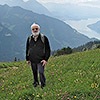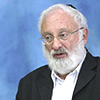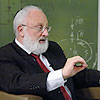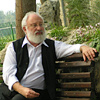The Screen Is Not Just A Partition, But An Entire System
 A person is a small world, which means the whole world is inside me. I stand facing the Upper Light and the Creator with all my properties and internal characteristics. I am unable to imagine anything outside myself.
A person is a small world, which means the whole world is inside me. I stand facing the Upper Light and the Creator with all my properties and internal characteristics. I am unable to imagine anything outside myself.
We have already gone through sufficient preparation in order to avoid associating what is written in The Zohar with images of our world, history or geography. We can now see the text as describing ourselves, the Creator and the screen between us and Him. Now we have to try to see the system and structure of the relationship that we have to build between us and Him.
The screen is not just a partition between the Creator and myself, but it is an entire system. After all, I am only a point of desire created “out of nothing” and the Creator is also just a point, a spark of Light that created me, the point of desire.
The screen refers to a huge system that exists between both points: me (a black point) and the Creator (a point of white Light). The screen is not positioned above the desire to enjoy, but is included in this desire. With the help of the screen I can calculate how closely I can align my desire to match the Light; this is why the screen should fully embrace my desire.
Rosh (the head) of the Partzuf is the place where I decide which part of my desire should become attached to the Light. The part of my desire that I am able to align with the Light is called Toch (the inner part) of the Partzuf. The part that I am still unable to align with the Light is called Sof (the end) of the Partzuf.
The screen operates within all of these parts, being a system that connects me with the Creator. The system is divided into three parts:
- Rosh, the head of the Partzuf, which performs a clarification and calculation
- Toch, the inner part of the Partzuf, which receives the Light and attains similarity with it in action
- Sof, the end of the Partzuf, where a separate calculation is performed regarding my inability to be similar to the Light
It’s not enough for me to simply decide what part of my desire I can make similar to the Creator and throw the rest away. I also have to check which parts I cannot align with the Creator and why. The end of the Partzuf has to be as clear as its inner part.
The Host is asking me about every minor detail: “Why don’t you want to accept Light into it from Me?” I then have to check that detail and explain to myself why I can’t receive inside it. Therefore, the screen is an entire system of connection between the Creator and myself; it is not simply the partition that we draw in our illustrations.
When studying The Zohar, we are constantly learning about this system – the connection between us and the Creator. I am below and the Creator is above, and between us there is an entire system we call “the screen,” which consists of three main parts. This system encompasses all the worlds.


 A question I received:
A question I received: 
 A question I received:
A question I received:  Questions I received on various Kabbalistic concepts and definitions:
Questions I received on various Kabbalistic concepts and definitions:








